Brand Strategy vs. Marketing Strategy: The Big Differences
The terms "brand strategy" and "marketing strategy" are often used interchangeably, though there are some nuanced differences.
These differences are important because success looks different for brand and marketing strategies, and you shouldn't measure them with the same KPIs.
In this post, we'll define each strategy, how they differ, and how to use them together to drive your broader business plan.
What Is a Brand Strategy?
A brand strategy is a company's long-term plan to define core values, establish a unique position in the marketplace, and then project that message to as many potential customers as possible.
A great brand strategy helps:
-
Elevate credibility and reputation.
-
Improve customer relationships and sentiment.
-
Increase the percentage of the target audience that has heard of the brand's name.
Some examples of initiatives that might be part of a brand strategy include:
- Content marketing that provides thought leadership opinions on industry trends.
- A logo redesign that better embodies a brand's core values and purpose.
- A new slogan or positioning statement.
As you can see, these initiatives don't immediately increase sales, but they increase the total number of people who hear about your brand and help shape those people's opinions of your brand.
It also helps with recruiting and culture development because it's clear what your brand stands for and what you're working towards.
The ultimate test for a brand strategy is – what do people feel when they hear our name?
Companies like Nike, Coca-Cola, and Disney have all mastered brand strategy and are excellent examples to replicate.
What Is a Marketing Strategy?
A marketing strategy is a plan to help a company achieve its growth goals by capturing the attention of its target customers and funneling them toward the sale.
A great marketing strategy helps:
- Drive more leads and sales.
- Increase market share.
- Improve profitability.
A marketing strategy typically consists of multiple marketing campaigns, each of which might use a different channel (social media, content marketing, SEO, etc.) and have a different objective (brand awareness, leads, etc.).
What Is the Difference Between Brand Strategy and Marketing Strategy?
As you probably noticed in the definitions above, there's a lot of overlap between brand and marketing strategies, though they aren't the same.
The main difference between a brand strategy and a marketing strategy is that a brand strategy's objectives shape who your company is and what it stands for. In contrast, most marketing strategy objectives are tactical and designed to drive direct business growth.
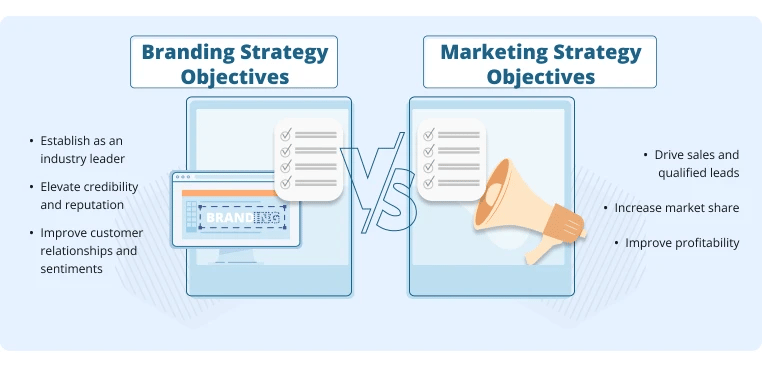
In addition, a marketing strategy frequently evolves as the digital marketing landscape changes, whereas a brand strategy rarely changes.
For example, a company like Nike has had the same core branding (message, logo, etc.) for decades, though how they communicate with their audience (social media channels, influencers, etc.) changes frequently.
Nevertheless, marketing and branding strategies work closely together to improve market share and support business growth.
To clearly illustrate the difference between a strong brand and marketing strategy, let's look at the weight loss company, Noom.
We'll outline three different campaign examples, including:
- A marketing campaign that is part of the marketing strategy but not the branding strategy.
- A marketing campaign that is part of the marketing strategy and branding strategy.
- A branding initiative that is part of the branding strategy, yet not necessarily the marketing strategy.
Marketing Strategy Campaign Example
Noom is running a Google ads campaign for keywords like "weight loss program for women." This is a great example of a marketing campaign.
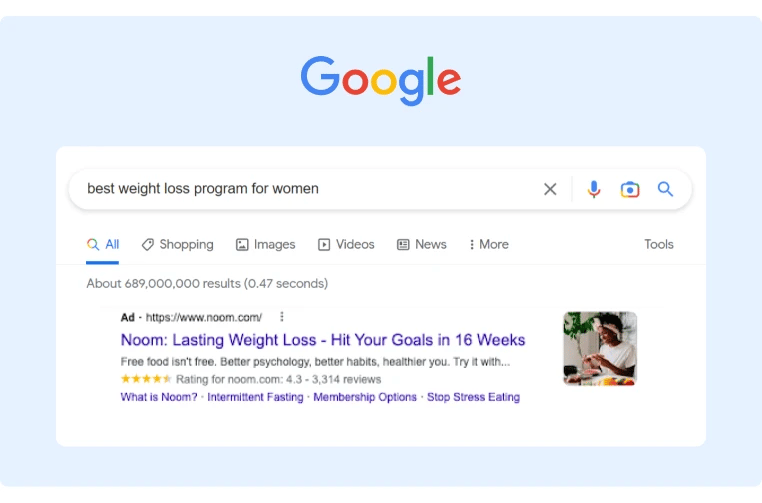
When you click on the ad, you'll see it takes you to a landing page designed to capture contact info and qualify leads:

While the ad arguably boosts brand awareness simply because people see the brand name, it doesn't communicate the brand's identity (e.g., core values, key strengths, unique positioning in the market, etc.). Instead, it's designed to drive leads and generate sales.
So, this marketing campaign is part of the broader marketing strategy but minimally aids the brand strategy.
Marketing and Branding Strategy Campaign Example
Noom also does a lot of affiliate marketing and PR campaigns. For example, this post on Healthline is part of Noom’s affiliate program:

This campaign is an excellent example of an initiative that aids both the brand and marketing strategies.
It aids the branding strategy because it helps Noom get in front of its target audience (people reading Healthline are probably interested in weight loss) and explain how the product works, Noom's core values, and how it's different from the competition.
However, it also aids the marketing strategy because it helps boost the SEO strategy and can help drive direct customers.
Branding Strategy Campaign Example
When Noom redesigned its logo several years ago, it gave the brand a fresh look and feel. The inspiration behind the logo redesign was fueled by the idea that Noom is designed to help people navigate healthier day-to-day and moment-to-moment choices.
They redesigned the logo to visually represent that change. Here's the before and after:
This change doesn't drive immediate sales and probably didn't significantly impact growth during that year.
However, it does visually reinforce how Noom differentiates itself in the marketplace and its core identity.
Therefore, the logo redesign is a great example of an initiative that's part of the brand strategy yet isn't really part of the marketing strategy.
How To Use Branding and Marketing Strategies To Drive Your Business Strategy
So, how do you use branding and marketing strategies together to drive your overarching business strategy?
Here's a simple roadmap to help you blend your brand strategy and marketing strategy (often referred to as a brand marketing strategy) to support your overall business goals.
Step 1: Define Your Core Values and Mission Statement
Branding starts internally.
If you don't know what you stand for and how you're different from the competition, your audience won't have a clear perception of your company either.
To ensure that your company has a strong brand identity, start by defining your core values and mission statement. This will also make it easier to outline brand guidelines.
So, how do you define your core values and mission?
There are plenty of resources that can help you do this, though I particularly like Gino Wickman's approach to defining core values:
-
List out your personal values.
-
Ask the leadership team to brainstorm core values.
-
Ask yourself: Is this who we are, who we want to be, or who we want to be seen as?
-
Commit to your core values.
Your mission statement should answer the question, "Why do we exist?"
This isn't a tactical KPI that you'll achieve but more of a direction your company is always striving towards.
Here are a few examples of mission statements:
-
Starbucks: To inspire and nurture the human spirit – one person, one cup, and one neighborhood at a time.
-
Intel: We create world-changing technology that improves the life of every person on the planet.
-
Meta: Giving people the power to build community and bring the world closer together.

Your core values and mission statement should very rarely – if ever – change.
Once you've defined your brand values and mission statement, you'll find it much easier to direct your branding and marketing strategies, as you won't have to wonder what kind of perception you're trying to create.
Step 2: Conduct Customer Research
Once the company is clear on its brand identity, the next step is to get in front of as many ideal customers as possible. To do that, conduct customer research.
Customer research will help you find the right channels to leverage to connect with customers and inform you how to tailor your messaging to capture potential customers' attention.
Here's a quick guide to customer research.
Step 1: Identify Your Most Profitable Customers
First, create a list of all your customers and then identify only the top 20% of the most profitable customers. (This is known as the 80/20 rule a.k.a. the Pareto Principle.)
Now, tailor the brand story and marketing strategy exclusively to those customers.
Think about it – if your most profitable customers generate 30% more profit than the average customer, you can grow your business's profitability by 30% simply by changing who you serve.
However, if you continue serving the average customer, your resources (which are finite) will only generate 70% of the profit that they could generate.
Step 2: Interview Your Most Profitable Customers
Once you've identified your most profitable customers, interview them to learn more about why they chose your business, their key pain points, and their general persona.
Here's a checklist you can use to guide the interview:
-
Demographics (for B2B): Company size, title, years in that position, etc.
-
Demographics (for B2C): Age, geographic location, gender, etc.
-
What was your biggest pain point before purchasing our product/service?
-
How were you solving this pain point before our product/service?
-
What are the top three benefits of using our product/service?
-
Was there an event that finally pushed you to look for a solution?
-
How long were you living with this pain point before purchasing our product/service?
-
How did you learn about our product/service?
-
Where do you typically hang out online?
-
What publications/newsletters do you read?
You can record the interview via Zoom or use revenue intelligence platforms like Gong or Jiminny to monitor for specific keywords mentioned in the course of your team's conversations.
However, if you want a more sophisticated interview tool, Discuss.io can also perform sentiment analysis, search for specific interview keywords, and more.
Step 3: Identify Common Patterns and Tailor Your Brand Messaging and Marketing Plan to That Persona
Once you’ve done the interviews, you can identify common pain points, where they hang out online, and commonly cited benefits of your products or services. Then, you can use that information to solidify your brand positioning and guide your marketing campaigns.
Next, let’s discuss how we can make this information actionable.
Step 3: Outline Marketing Campaigns To Achieve Business Goals
Now that you've defined who you are as a brand and identified your best customers, it's time to connect the brand with the ideal customer.
The vehicle to make this connection happen is the marketing strategy. And the next step is to plan out a handful of marketing campaigns and test them.
So, how do you decide which marketing campaigns to test first? We have an entire guide on building a marketing strategy, but to help you get started, sketch out a sample marketing funnel.
Your first marketing funnel idea can include plenty of different channels and campaigns, and then you can refine it. The point of this exercise is to get as many options down as possible.
Here's a basic marketing funnel template:
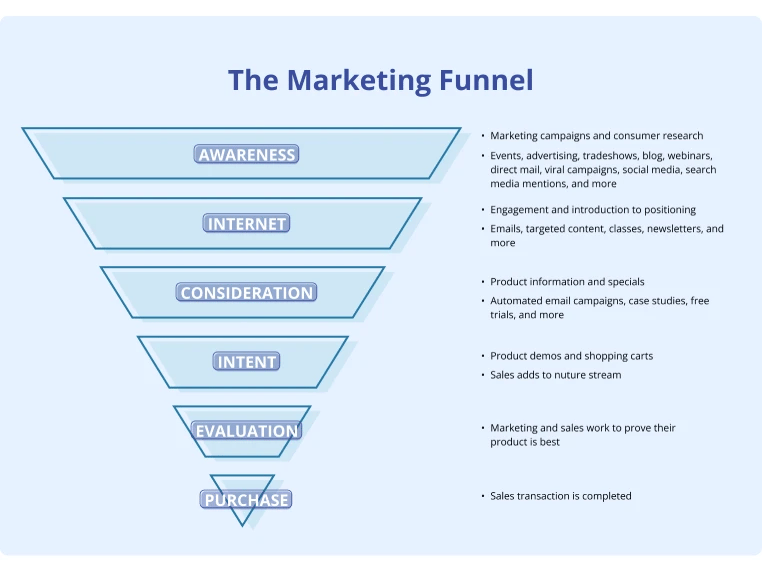
While the above marketing funnel is a sample template, here’s an example of a slightly simpler marketing funnel you might create:
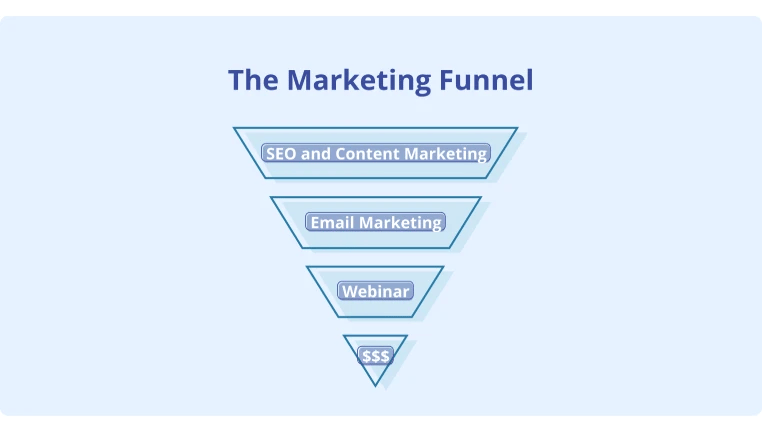
Once you've narrowed down the tactics you plan to use for your marketing strategy, plan out the specific marketing campaigns you'll run.
For example, plan out your SEO, content, email, and webinar strategies for the sample marketing funnel above.
For SEO, plan out the keywords you'll target, how many blog posts you plan to write, the metrics you'll track, and specific goals for each month, quarter, and year.
This will help you budget effectively and see which marketing campaigns are most profitable.
Step 4: Execute the Plan With Consistency
Most people can create a sound marketing and branding strategy, though the real challenge is sticking to that plan even as new opportunities arise. However, if you stick to the plan you laid out above and execute it consistently, you should meet your goals.
So, how can you improve execution consistency?
First, avoid new distractions (trendy marketing tactics, channels, etc.). Next create systems and processes that ensure the execution happens automatically, which significantly improves results.
To create effective systems and processes, start by investing in a project management tool like Monday.com or Asana.
Project management tools can help you identify:
-
What: How can you break down the campaign into smaller steps?
-
Who: What people do you need to hire for each project step?
-
When: What's a reasonable timeline for each micro-step of the project?
From there, you can add people, deadlines, and tasks to the project management tool, and your whole team can view project progress.
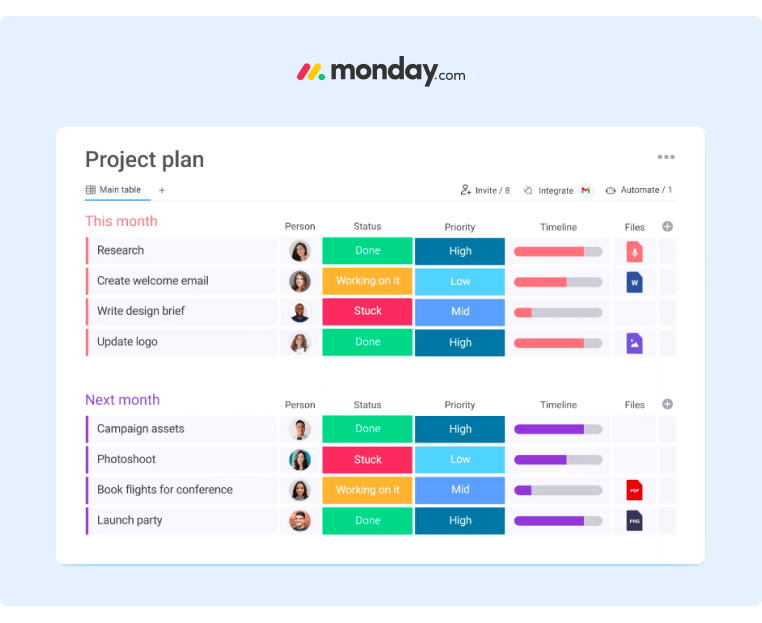
You can also add stakeholders and managers if they want to track project status.
In addition, you can upload branding guidelines to the project management tool to ensure all marketing campaigns align with your core messaging.
Step 5: Measure Qualitative and Quantitative Results
Most marketers overcomplicate growth.
However, you really just need to identify the strategies that brought you the most profitable customers (at the lowest cost) and then double down on that.
At the end of each quarter, look at which marketing campaigns drove the best results and then allocate more resources to those strategies.
The only exception to this rule is for long-term strategies that require months to generate an ROI. For example, SEO and content marketing typically require months to generate an ROI.
So, how do you know if you should continue investing in those strategies? First, you can also look at your competitors' marketing strategy and see if they're heavily investing in those channels.
For example, how many blog posts are they publishing per month?

If your competitors are heavily investing in a particular marketing channel, there's a good chance it's working, and you could also benefit from investing in that marketing channel.
Then, use metrics other than conversions (like traffic, engagement, and return visitor percentage) to gauge your marketing campaign's success.
While your marketing campaigns should have relatively short-term goals, you should also look at long-term branding metrics like total brand mentions over time, brand sentiment, customer reviews, and market share percentage.
You can use a tool like Google Trends to measure a brand's mentions over time:

You can also use a tool like Semrush to gauge general market share or track your competitors’ market share:

Create a Brand Strategy and Marketing Strategy That Works Together
Your brand strategy communicates who you are as a company and what you stand for, and your marketing strategy should help you get that message in front of as many ideal customers as possible.
So even though there are differences in the execution between the two, they both work together to help your company grow into a market leader.
If you want a tool to help improve your branding and marketing strategies, consider our tool, GaggleAMP. It helps you automate the employee engagement process by allowing managers to assign specific engagement activities to individual employees at scale. You can learn more about it by scheduling a demo.











